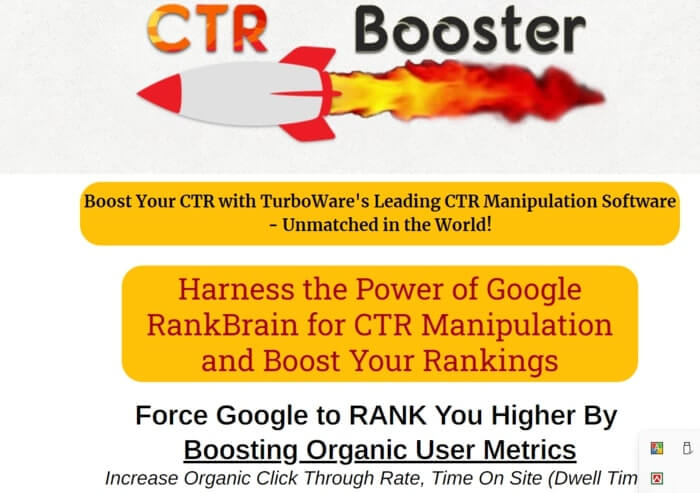CTR Manipulation: Unlock Higher Organic Website Traffic With Optimized Click-Through Fees
CTR Manipulation: Unlock Higher Organic Website Traffic With Optimized Click-Through Fees
Blog Article
Maximize Click-Through Rates With CTR Adjustment Approaches
Maximizing click-through prices (CTR) is a critical facet of digital marketing, requiring a nuanced understanding of user habits and critical implementation of control strategies. By focusing on components such as emotional triggers and compelling headlines, marketing professionals can considerably improve individual interaction. Furthermore, A/B testing permits the recognition of impactful variations, while effective use visuals can boost call-to-action exposure. Nevertheless, the path to making the most of CTR is not straightforward; it demands a comprehensive analysis of user communications and choices. What ingenious approaches could further improve these methods?
Recognizing Click-Through Rates
Comprehending click-through prices (CTR) is necessary for assessing the effectiveness of on-line marketing strategies. CTR is a vital performance indication that measures the proportion of users that click a certain link to the number of complete customers who check out a e-mail, page, or advertisement . This statistics provides useful understanding right into just how well content resonates with the target market, functioning as a crucial sign of involvement.
A higher CTR frequently indicates that the content is appropriate and engaging, while a reduced CTR may suggest that adjustments are needed in the messaging or targeting techniques - CTR Manipulation. CTR is particularly significant in the context of digital advertising and e-mail campaigns, where the goal is to drive web traffic and conversions
Moreover, comprehending the elements that affect CTR-- such as audience targeting, ad positioning, and overall style-- allows online marketers to make data-driven decisions. Assessing CTR trends gradually can also help determine effective strategies and locations for renovation. By adequately understanding CTR, services can fine-tune their marketing methods, make best use of return on investment, and ultimately foster more powerful links with their target market.
Crafting Compelling Headlines

First, clarity makes certain that the reader immediately recognizes the value of the content. Second, importance is critical; headings ought to reverberate with the target audience's interests and demands, resolving their pain points or wishes.
Additionally, incorporating emotional triggers can boost a headline's efficiency. Phrasing that stimulates excitement, interest, or necessity can force viewers to click. Utilizing numbers, such as "5 Tips for Better Rest," can additionally create a feeling of uniqueness and assurance workable insights.
Lastly, brevity is important-- headings must be succinct sufficient to be conveniently digestible while maintaining their influence. By stabilizing these aspects, online marketers can craft headings that not only stand out however also drive higher click-through prices, ultimately improving involvement with the material.
Utilizing A/B Examining
A/B testing is an effective method that permits marketers to compare two variations of a headline or web content piece to identify which does much better in terms of click-through rates. By separating one variable-- such as wording, call-to-action, or placement-- marketers can efficiently gauge audience preferences and enhance their content look at this site as necessary.
To carry out A/B screening, it is essential to pick a depictive example of your target market. Each participant ought to be randomly designated to either the control group (original version) or the experimental group (changed version) This technique makes sure that the outcomes are statistically valid and lessens prejudices.
Once the test is applied, monitor efficiency metrics carefully. Examine information over an adequate timeframe to make up fluctuations in user habits. Secret metrics to observe consist of conversion rates, time invested in the web page, and overall engagement.
After collecting data, contrast the results to identify which version accomplished higher click-through rates. Use these understandings to inform future content techniques, enhancing your general digital marketing initiatives. A/B testing not just aids in improving CTR but likewise promotes a culture of data-driven decision-making within advertising groups.
Leveraging Visual Components
Aesthetic elements play an essential function in boosting click-through prices (CTR) by capturing the target market's attention and sharing messages better. The tactical use of images, video clips, and graphics can dramatically influence individual interaction and drive action. Top notch visuals that relate to the web content can create an emotional link with individuals, encouraging them to click through to find out more.
Incorporating different shades for call-to-action buttons can additionally improve visibility, making them stand out on the page. Research shows that buttons in intense shades have a tendency to execute much better than those in muted tones. Additionally, utilizing infographics and visually enticing designs can damage down complicated details, making it a lot more absorbable for individuals and prompting them to explore even more.
Animations, when made use of judiciously, can draw interest and boost interactivity, therefore raising CTR. Ultimately, leveraging visual elements efficiently calls for a balance in between visual charm and functional clearness to enhance CTR and accomplish marketing goals.
Analyzing User Behavior
Comprehending individual behavior is important for optimizing click-through rates (CTR) and refining advertising and marketing methods. By thoroughly evaluating exactly how users interact with content, marketers can determine patterns that educate much more effective CTR adjustment methods.
To begin, analyzing click patterns-- such as peak interaction times and preferred web content kinds-- can provide important understandings. Devices like warm maps and the original source session recordings can disclose which components attract focus and which are ignored. Moreover, segmentation of user demographics permits marketing experts to tailor their approaches, making sure that messaging reverberates with distinctive audience groups.
In addition, tracking user journeys can light up prospective friction factors that prevent interaction. Recognizing where users drop off can bring about strategic changes in web content layout or call-to-action positioning, improving general efficiency.

Conclusion
Finally, optimizing click-through rates necessitates a complex technique that incorporates calculated headline crafting, A/B screening, efficient visual aspects, and thorough individual behavior evaluation. CTR Manipulation. By executing these control techniques, web content creators can dramatically enhance individual interaction and drive website traffic. Continuous improvement and adaptation to target market preferences will certainly additionally add to enhanced CTR and conversion rates, eventually leading to higher success in digital marketing efforts. The assimilation of these strategies is vital for maximizing online presence and impact.

Report this page